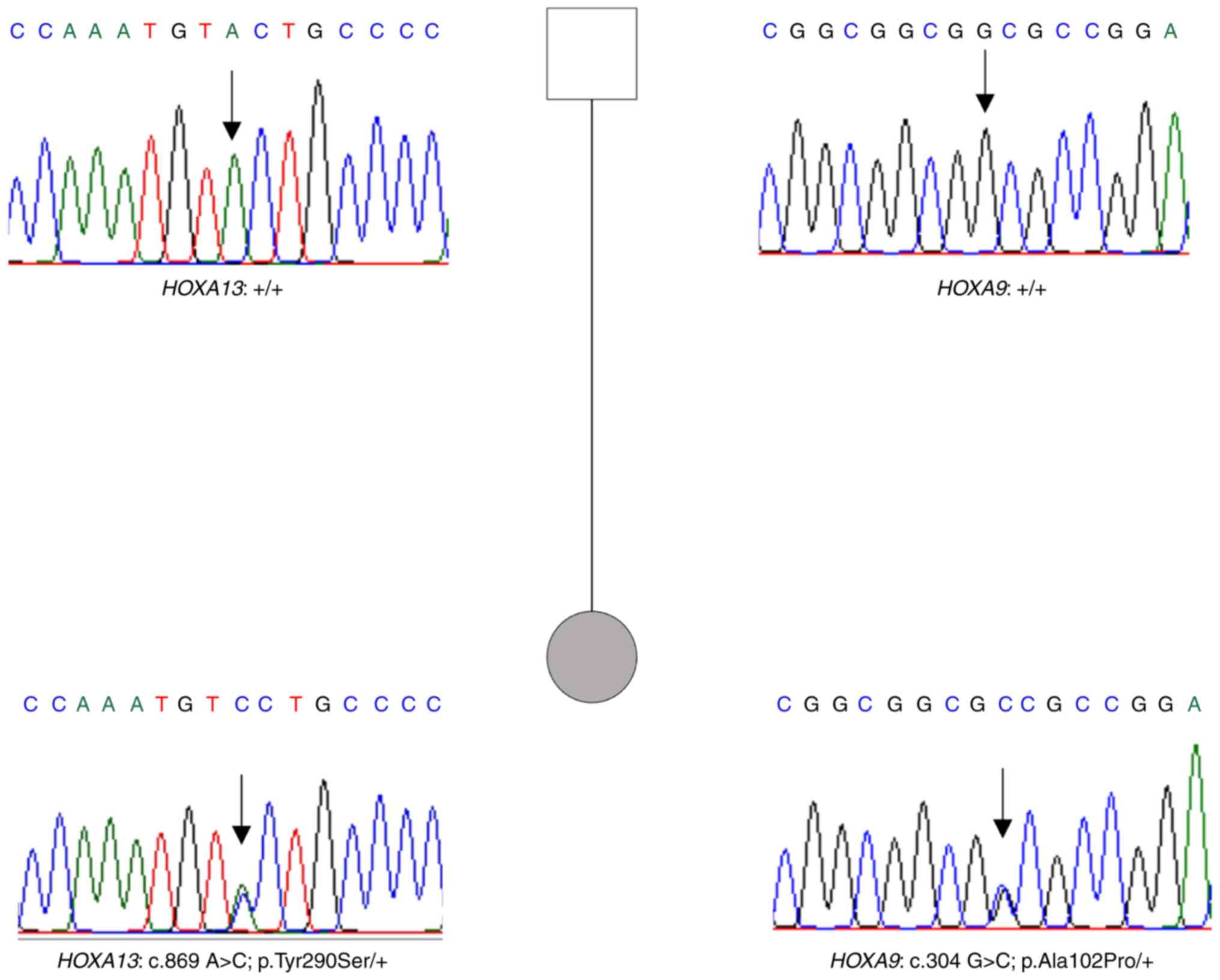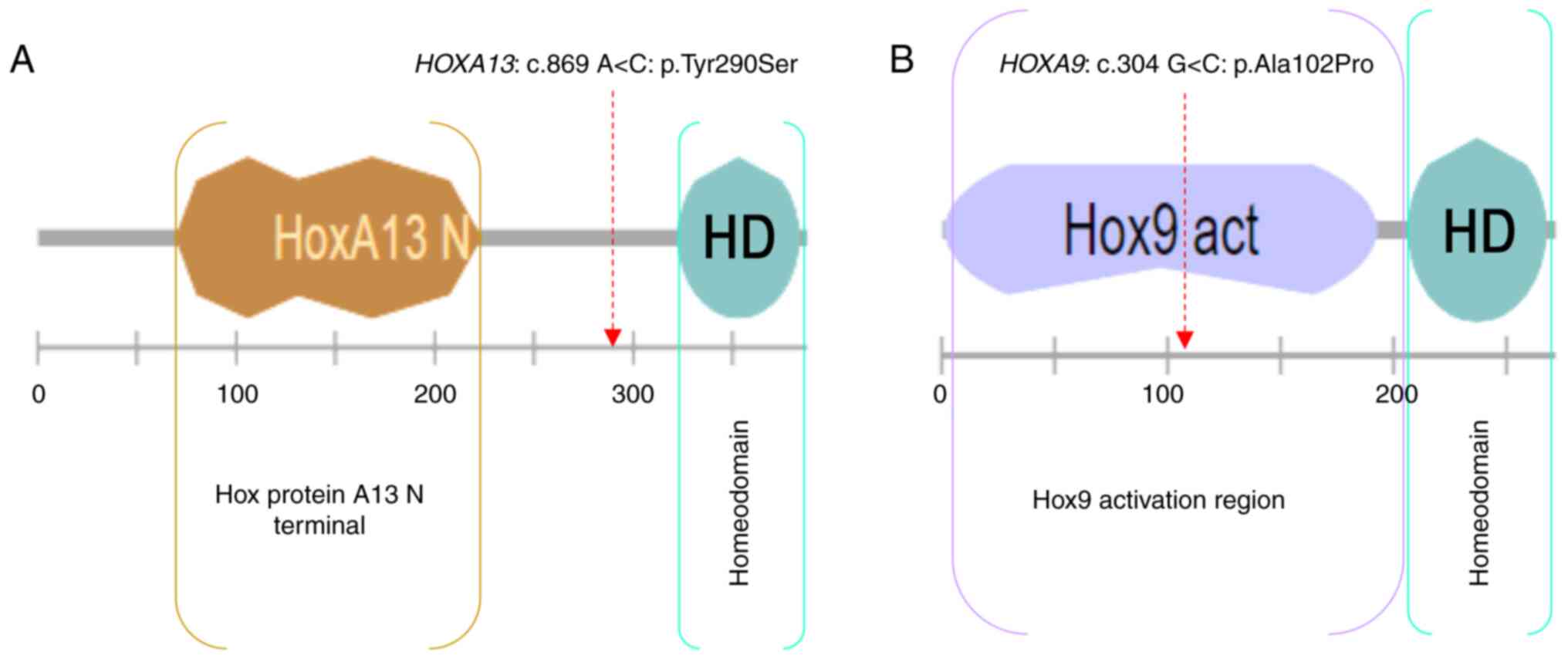|
1
|
Krumlauf R: Hox genes, clusters and
collinearity. Int J Dev Biol. 62:659–663. 2018. View Article : Google Scholar : PubMed/NCBI
|
|
2
|
Mallo M and Alonso CR: The regulation of
Hox gene expression during animal development. Development.
140:3951–3963. 2013. View Article : Google Scholar : PubMed/NCBI
|
|
3
|
Favier B and Dollé P: Developmental
functions of mammalian Hox genes. Mol Hum Reprod. 3:115–131. 1997.
View Article : Google Scholar : PubMed/NCBI
|
|
4
|
Quinonez SC and Innis JW: Human HOX gene
disorders. Mol Genet Metab. 111:4–15. 2014. View Article : Google Scholar : PubMed/NCBI
|
|
5
|
Du H and Taylor HS: The role of Hox genes
in female reproductive tract development, adult function, and
fertility. Cold Spring Harb Perspect Med. 6:a0230022015. View Article : Google Scholar : PubMed/NCBI
|
|
6
|
Cao L, Chen C, Leng Y, Yan L, Wang S,
Zhang X and Luo Y: A missense mutation of HOXA13 underlies
hand-foot-genital syndrome in a Chinese family. J Genet.
96:647–652. 2017. View Article : Google Scholar : PubMed/NCBI
|
|
7
|
Jorgensen EM, Ruman JI, Doherty L and
Taylor HS: A novel mutation of HOXA13 in a family with
hand-foot-genital syndrome and the role of polyalanine expansions
in the spectrum of Müllerian fusion anomalies. Fertil Steril.
94:1235–1238. 2010. View Article : Google Scholar : PubMed/NCBI
|
|
8
|
Roux M, Bouchard M and Kmita M:
Multifaceted Hoxa13 function in urogenital development underlies
the hand-foot-genital syndrome. Hum Mol Genet. 28:1671–1681. 2019.
View Article : Google Scholar : PubMed/NCBI
|
|
9
|
Mortlock DP and Innis JW: Mutation of
HOXA13 in hand-foot-genital syndrome. Nat Genet. 15:179–180. 1997.
View Article : Google Scholar : PubMed/NCBI
|
|
10
|
Goodman FR, Bacchelli C, Brady AF, Brueton
LA, Fryns JP, Mortlock DP, Innis JW, Holmes LB, Donnenfeld AE,
Feingold M, et al: Novel HOXA13 mutations and the phenotypic
spectrum of hand-foot-genital syndrome. Am J Hum Genet. 67:197–202.
2000. View
Article : Google Scholar : PubMed/NCBI
|
|
11
|
Imagawa E, Kayserili H, Nishimura G,
Nakashima M, Tsurusaki Y, Saitsu H, Ikegawa S, Matsumoto N and
Miyake N: Severe manifestations of hand-foot-genital syndrome
associated with a novel HOXA13 mutation. Am J Med Genet A.
164A:2398–2402. 2014. View Article : Google Scholar : PubMed/NCBI
|
|
12
|
Wallis M, Tsurusaki Y, Burgess T, Borzi P,
Matsumoto N, Miyake N, True D and Patel C: Dual genetic diagnoses:
Atypical hand-foot-genital syndrome and developmental delay due to
de novo mutations in HOXA13 and NRXN1. Am J Med Genet A.
170:717–724. 2016. View Article : Google Scholar : PubMed/NCBI
|
|
13
|
Guttmacher AE: Autosomal dominant preaxial
deficiency, postaxial polydactyly, and hypospadias. Am J Med Genet.
46:219–222. 1993. View Article : Google Scholar : PubMed/NCBI
|
|
14
|
Innis JW, Goodman FR, Bacchelli C,
Williams TM, Mortlock DP, Sateesh P, Scambler PJ, McKinnon W and
Guttmacher AE: A HOXA13 allele with a missense mutation in the
homeobox and a dinucleotide deletion in the promoter underlies
Guttmacher syndrome. Hum Mutat. 19:573–574. 2002. View Article : Google Scholar : PubMed/NCBI
|
|
15
|
Solomon BD, Bear KA, Kimonis V, de Klein
A, Scott DA, Shaw-Smith C, Tibboel D, Reutter H and Giampietro PF:
Clinical geneticists' views of VACTERL/VATER association. Am J Med
Genet A. 158A:3087–3100. 2012. View Article : Google Scholar : PubMed/NCBI
|
|
16
|
van de Putte R, Dworschak GC, Brosens E,
Reutter HM, Marcelis CLM, Acuna-Hidalgo R, Kurtas NE, Steehouwer M,
Dunwoodie SL, Schmiedeke E, et al: A genetics-first approach
revealed monogenic disorders in patients with ARM and VACTERL
anomalies. Front Pediatr. 8:3102020. View Article : Google Scholar : PubMed/NCBI
|
|
17
|
Solomon BD, Baker LA, Bear KA, Cunningham
BK, Giampietro PF, Hadigan C, Hadley DW, Harrison S, Levitt MA,
Niforatos N, et al: An approach to the identification of anomalies
and etiologies in neonates with identified or suspected VACTERL
(vertebral defects, anal atresia, tracheo-esophageal fistula with
esophageal atresia, cardiac defects, renal and limb anomalies)
association. J Pediatr. 164:451–457.e1. 2014. View Article : Google Scholar : PubMed/NCBI
|
|
18
|
Garcia-Barceló MM, Wong KK, Lui VC, Yuan
ZW, So MT, Ngan ES, Miao XP, Chung PH, Khong PL and Tam PK:
Identification of a HOXD13 mutation in a VACTERL patient. Am J Med
Genet A. 146A:3181–3185. 2008. View Article : Google Scholar : PubMed/NCBI
|
|
19
|
Kang J, Mao M, Zhang Y, Ai FF and Zhu L:
Congenital anal atresia with rectovestibular fistula, scoliosis,
unilateral renal agenesis, and finger defect (VACTERL association)
in a patient with partial bicornuate uterus and distal vaginal
atresia: A case report. Medicine (Baltimore). 97:e128222018.
View Article : Google Scholar : PubMed/NCBI
|
|
20
|
Komura M, Kanamori Y, Sugiyama M, Tomonaga
T, Suzuki K, Hashizume K and Goishi K: A female infant who had both
complete VACTERL association and MURCS association: Report of a
case. Surg Today. 37:878–880. 2007. View Article : Google Scholar : PubMed/NCBI
|
|
21
|
Obeidat RA, Aleshawi AJ, Tashtush NA and
Alsarawi H: Unicornuate uterus with a rudimentary non-communicating
cavitary horn in association with VACTERL association: Case report.
BMC Womens Health. 19:712019. View Article : Google Scholar : PubMed/NCBI
|
|
22
|
Balusamy SL, Kumar D and Subrahmanian SR:
MURCS and VACTERL association in a 27 year old female. J Obstet
Gynaecol. 29:762–763. 2009. View Article : Google Scholar : PubMed/NCBI
|
|
23
|
Stephenson JD, Laskowski RA, Nightingale
A, Hurles ME and Thornton JM: VarMap: A web tool for mapping
genomic coordinates to protein sequence and structure and
retrieving protein structural annotations. Bioinformatics.
35:4854–4856. 2019.Available from:. https://academic.oup.com/bioinformatics/article/35/22/4854/5514476
View Article : Google Scholar : PubMed/NCBI
|
|
24
|
Goodman FR and Scambler PJ: Human HOX gene
mutations. Clin Genet. 59:1–11. 2001. View Article : Google Scholar : PubMed/NCBI
|
|
25
|
Taylor HS: The role of HOX genes in the
development and function of the female reproductive tract. Semin
Reprod Med. 18:81–89. 2000. View Article : Google Scholar : PubMed/NCBI
|
|
26
|
He B, Ni ZL, Kong SB, Lu JH and Wang HB:
Homeobox genes for embryo implantation: From mouse to human. Animal
Model Exp Med. 1:14–22. 2018. View Article : Google Scholar : PubMed/NCBI
|
|
27
|
Sitwala KV, Dandekar MN and Hess JL: HOX
proteins and leukemia. Int J Clin Exp Pathol. 1:461–474.
2008.PubMed/NCBI
|
|
28
|
Aryal S, Zhang Y, Wren S, Li C and Lu R:
Molecular regulators of HOXA9 in acute myeloid leukemia. FEBS J.
Nov 7–2021.(Epub ahead of print). PubMed/NCBI
|
|
29
|
Pérez-Cabrera A, Kofman-Alfaro S and
Zenteno JC: Mutational analysis of HOXD13 and HOXA13 genes in the
triphalangeal thumb-brachyectrodactyly syndrome. J Orthop Res.
20:899–901. 2002. View Article : Google Scholar : PubMed/NCBI
|
|
30
|
Stern AM, Gall JC Jr, Perry BL, Stimson
CW, Weitkamp LR and Poznanski AK: The hand-food-uterus syndrome: A
new hereditary disorder characterized by hand and foot dysplasia,
dermatoglyphic abnormalities, and partial duplication of the female
genital tract. J Pediatr. 77:109–116. 1970. View Article : Google Scholar : PubMed/NCBI
|
|
31
|
Frisén L, Lagerstedt K, Tapper-Persson M,
Kockum I and Nordenskjöld A: A novel duplication in the HOXA13 gene
in a family with atypical hand-foot-genital syndrome. J Med Genet.
40:e492003. View Article : Google Scholar : PubMed/NCBI
|
|
32
|
Innis JW, Mortlock D, Chen Z, Ludwig M,
Williams ME, Williams TM, Doyle CD, Shao Z, Glynn M, Mikulic D, et
al: Polyalanine expansion in HOXA13: Three new affected families
and the molecular consequences in a mouse model. Hum Mol Genet.
13:2841–2851. 2004. View Article : Google Scholar : PubMed/NCBI
|
|
33
|
Thompson AA and Nguyen LT: Amegakaryocytic
thrombocytopenia and radio-ulnar synostosis are associated with
HOXA11 mutation. Nat Genet. 26:397–398. 2000. View Article : Google Scholar : PubMed/NCBI
|















